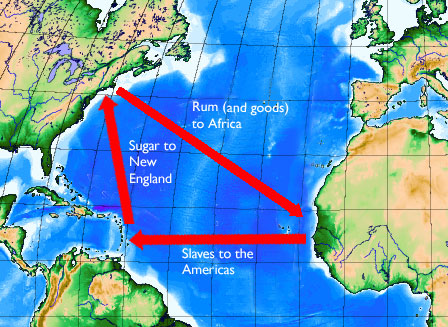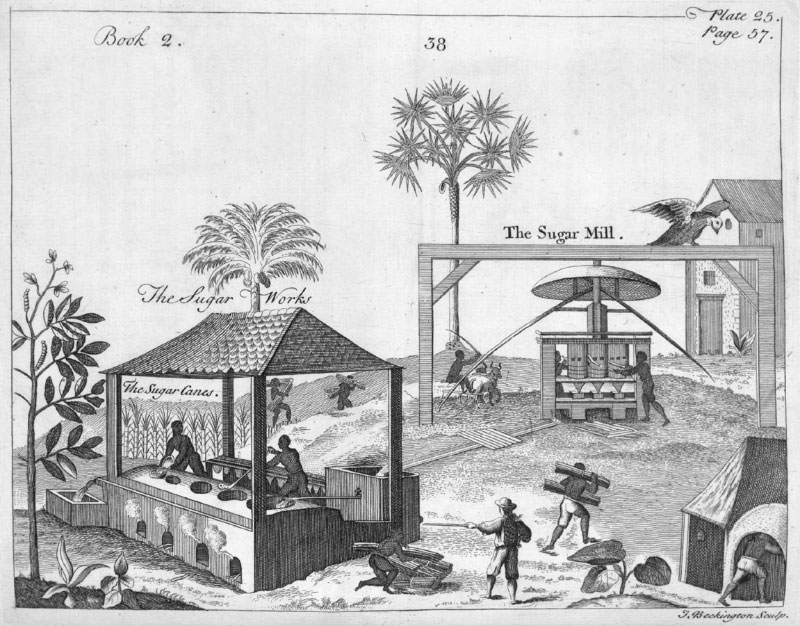IFP Week 5: Sugar, Power, and Empire
Matt Price
Defining Sugar: Chemistry

Defining Sugar: Botany and History

(Not Just) Triangular Trade
- New world sugar production, which gained prominence in Brazil and then in the Caribbean, relied heavily on slave labour (as discussed re: chocolate)
- often depicted as "triangular trade", though the reality was far more complex
- sidenote: we learn "triangular trade" as an example of the theory of mercantilism
- don't be fooled by the ideology of these deeply immoral slaveholders!
- in general, any large-scale abstraction will contain simplifications that can be pernicious
but also begs question: why sugar in particular?
At the time that the Portuguese and the Spaniards set out to establish a sugar industry on the Atlantic islands they controlled , sugar was still a luxury , a medicine , and a spice in western Europe. (Mintz, 1985, p. 30)


Sugar Production
- sugar harvest machete-based and injury prone from a very early phase
- while molasses and unrefined sugars can be produced with relatively unsophisticated machinery, white sugar requires more complex processes
- child and adult slave labour made possible increasing sugar outputs, not via increasing agricultural yields, but simply by increasing labour inputs
- in this sense, "insustry" predates "industrial revolution"
So rapid was the motion of the mill, and so rapid also the combustion of the dried canes or "trash" used as fuel in the boiling house that the work of the millers and firemen, though light enough in itself, was exhausting. A French writer described as "prodigious " the galloping of the mules attached to the sweeps of the mill; but "still more surprising" in his opinion was the ceaseless celerity with which the firemen kept up a full blaze of cane-trash. Those who fed the mill were liable, especially when tired or half-asleep, to have their fingers caught between the rollers. A hatchet was kept in readiness to sever the arm, which in such cases was always drawn in; and this no doubt explains the number of maimed watchmen. (Mintz, 1985, p. 50)


The Sugar Market & Sugar Consumption
- what began as a luxury good, a medicine, and a spice, became a commodity, a food, and a part of daily life for all classes
- in this it mirrors, enables, and expands on the adoption of other stimulants
- Easiest to follow in England, which became the most powerful empire in the world, and controlled large percentage of the sugar trade (but also visible in other large empires)
- an interesting example is preserved fruit, which was known from the 15th century
- a luxury item of royal courts even in 1600, when it was still extremely expensive and difficult to prepare
- prices start to decline around 1650, and onsumption increases, first in tea, later in prepared foods
- not until 1800 or so did it become available to the general public, and only in about 1875 was it a working-class product (Mintz, 1985, p. 126)
- an interesting example is preserved fruit, which was known from the 15th century

Sugar and Power
- a valuable commodity, so a worthwhile investment
- based on slave labour, so potentially very profitable
- a symbol of imperial power, much like tea
- a complex set of captive relationships
- the increasing importance of sugar put pressure on British crown to support it.
- a self-reinforcing cycle, in this case "vicious", not "virtuous"
- the "freedom to choose commodities" opposed to other freedoms
Sugar, Health, and Ecology
- a major destructive force in the rain forest
- devastating effects on human health
Explanation in history
- biological urges?
- economic drivers?
- changes in desire, i.e., cultural drivers?